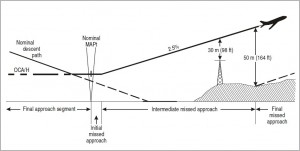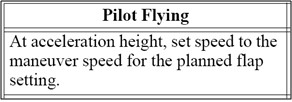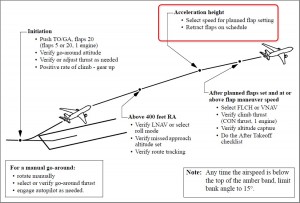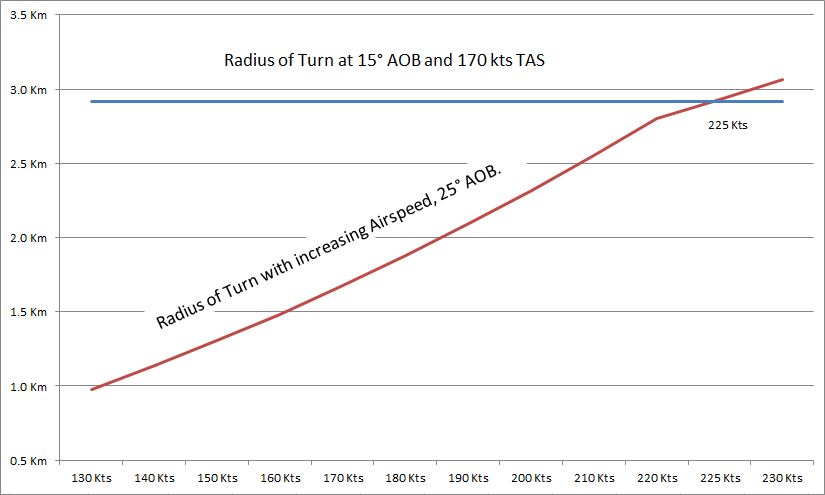I’ve recently been contacted by a friend from a previous airline who now works for another Middle Eastern carrier, flying 777’s. Interestingly enough – he’s chasing down information on Missed Approach Acceleration – an issue I also encountered when I arrived here at V in 2008.
Essentially at that time the initial training for the 777 Type Rating was provided in our own 777 Flight Simulator by Alteon, which is now a Boeing Company. While the contract required that our in house developed SOPs (based primarily on Boeing FCOM/FCTM documentation) were to be taught to our transitioning pilots – we encountered a number of stumbling blocks. One of these was Missed Approach Acceleration.
Note : This post has been updated to include some analysis on turn radius and potentially compromising the calculated splay by accelerating prior to MAA/MSA.
Background
 At the bottom of an instrument approach, if visual reference is not established the crew are required to execute the Go-Around procedure and commence a Missed Approach. Initially configured for landing – the undercarriage is raised and some of the landing flap is retracted in the go-around procedure as the aircraft transitions from the descent to a climb.
At the bottom of an instrument approach, if visual reference is not established the crew are required to execute the Go-Around procedure and commence a Missed Approach. Initially configured for landing – the undercarriage is raised and some of the landing flap is retracted in the go-around procedure as the aircraft transitions from the descent to a climb.
This is the beginning of the Missed Approach Procedure. While the procedure may involve lateral manoeuvring (turns) – what I’m primarily concerned with here is the vertical component.
From an initial climb speed of essentially the final approach speed, at some point the aircraft will need to accelerate, retract flap and reduce thrust from the go around (typically maximum) thrust setting to something like Climb/Max Continuous and establish level flight at a safe altitude. The bone of contention is when that acceleration phase commences. When I arrived, our students we being taught to accelerate at 1000 ft AAL in the missed approach, in common with the take off profile.
However a missed approach often does not follow the same departure track as a take off, and while intermediate acceleration for engine out departure profiles is assessed – this is not the case for engine out missed approach climb.
Boeing References
There area number of Boeing FCOM and FCTM references in this area.
 FCOM NP 21.40 “Go-Around and Missed Approach Procedure”
FCOM NP 21.40 “Go-Around and Missed Approach Procedure”
The FCOM normal procedures reference specifies acceleration at “acceleration height”. This term is not defined elsewhere in the FCOM or FCTM.
— — — — — —
 FCTM 5.64 “Go-Around and Missed Approach – All Approaches”
FCTM 5.64 “Go-Around and Missed Approach – All Approaches”
The go-around profile diagram in the FCTM again refers to “Acceleration height” without further defining this term.
— — — — — —
FCTM 5.58 “Go-Around and Missed Approach – All Engines Operating”
This section covers in detail the acceleration and flap retraction segment of the missed approach in more detail.
Go-Around and Missed Approach – All Engines Operating
The minimum altitude for flap retraction during a normal takeoff is not normally applicable to a missed approach procedure. However, obstacles in the missed approach flight path must be taken into consideration. During training, use 1,000 feet AGL to initiate acceleration for flap retraction, as during the takeoff procedure.
If initial manoeuvring is required during the missed approach, do the missed approach procedure through gear up before initiating the turn. Delay further flap retraction until initial manoeuvring is complete and a safe altitude and appropriate speed are attained.
Command speed should not be increased until a safe altitude and acceleration height is attained. Accelerate to flap retraction speed by repositioning the command speed to the manoeuvre speed for the desired flap setting. Retract flaps on the normal flap/speed schedule. When the flaps are retracted to the desired position and the airspeed approaches manoeuvre speed, select FLCH or VNAV and ensure CLB thrust is set. Verify the airplane levels off at selected altitude and proper speed is maintained.
Acceleration subsequent to a Go-Around should not be commenced until:
- Initial manoeuvring is complete.
- A safe altitude (or flap retraction altitude) and appropriate speed have been obtained.
- Obstacles in the missed approach flight path must be taken into consideration.
- During Training, 1000 ft AGL may be used to initial acceleration for flap retracting, based on the procedure used during Take Off.
The FCTM does not differentiate the acceleration and flap retraction stage of a go‑around for engine out operation. In fact the recommendation is that the same procedure is to be used.
Go-Around and Missed Approach – One Engine Inoperative
The missed approach with an engine inoperative should be accomplished in the same manner as a normal missed approach except use flaps 5 for the go-around flap setting for a flaps 20 approach or use flaps 20 as the go-around flap setting for a flaps 25 or 30 approach. After TO/GA is engaged, the AFDS commands a speed that is normally between command speed and command speed + 15 knots. The rudder is automatically positioned by the TAC to compensate for differential thrust with minimal input required from the pilot. Select maximum continuous thrust when flaps are retracted to the desired flap setting.
This implies that acceleration and flap retraction during an engine out go-around:
- Should not be commenced until the same criteria has been met as for a normal go-around;
- That the same procedure is advisable for both All Engine and Engine Out manoeuvres;
- That 1000 ft AGL should be used during Training.
The Problem – Missed Approach Acceleration at 1000 ft AAL
This is the crux of our problem. Owing to the references in the FCTM to acceleration at 1000 ft AAL “During Training” – Boeing/Alteon teach their/our students that Missed Approach Acceleration (both All Engine and Engine Out) requires acceleration to be commenced at 1000 ft in the missed approach. This is actioned by increasing the speed on the MCP – and it’s wrong.
As we’ll see below – ICAO PANS OPS has no concept of acceleration and clean up in the middle of a missed approach. While it’s true that there is a concept of initial, intermediate and final missed approach segments, these refer to climb profile (initial missed approach finishes as the aircraft reaches positive climb in the missed approach manoeuvre) and terrain clearance – there’s an increased terrain clearance requirement in the final missed approach segment.
The primary reference document here for us is the ICAO document 8168-OPS/611 (volumes 1 and 2).
PANS OPS Missed Approach Procedure Acceleration
 An instrument approach requires a maximum nominal gradient of 2.5% from the commencement of the intermediate missed approach segment, to the completion of the final missed approach segment.
An instrument approach requires a maximum nominal gradient of 2.5% from the commencement of the intermediate missed approach segment, to the completion of the final missed approach segment.
Terrain at certain airports may require gradients in excess of this in which case this is documented on the relevant approach plate.
The missed approach path is segmented into Initial, Intermediate and Final – with associated limiting speeds (Cat D aircraft) of Intermediate 345 kph (186 knots) and Final 490 kph (264 Knots). The delimiter between the intermediate and final missed approach segments is the obstacle clearance achievable.
As such, while the speed limit associated with the missed approach construction should allow acceleration to Vref 30+80 after a go-around, the missed approach path construction itself does not include any allowance for an acceleration segment. This does not mean intermediate acceleration cannot be undertaken – but no terrain clearance allowance is made. The aircraft must clear 2.5% from the MAP (Missed Approach Point) to the MAA (Missed Approach Altitude).
As primarily a JAR-OPS airline, a detailed examination of the FAA United States Standard for Terminal Instrument Procedures (TERPS) documentation has not been completed for this issue. However it is know that an intermediate acceleration segment is not part of the American regulations, and minimum gradients of anywhere from 2.1% to 3.3% are in use, terrain notwithstanding.
Procedural Commonality – All Engine vs Engine Out
Because of the excess thrust available during a two engine missed approach, an intermediate acceleration segment could potentially be scheduled during a two engine missed approach and still allow the aircraft to remain clear of terrain. However this would mean documenting, training and relying on the recall of two different procedures for the missed approach, depending on whether this is flown with one engine inoperative or not. Most airlines reach the conclusion that this carries an unacceptable safety risk against an acceptable loss of potential engine wear and tear and extra fuel usage for the relatively few two engine go-arounds that are encountered in normal line operations.
Many crew have enough difficulty scheduling a 1000 ft acceleration during an all engine missed approach, without having to remember not to do it during an engine out missed approach.
Engine Thrust Limits
Extending the missed approach segment to the MAA has the potential to infringe on the 5 minute limit on engine thrust in excess of Maximum Continuous Thrust (all engine) or the 10 minute limit on engine out thrust in excess of CON thrust.
However the risk of an exceedence of the 5 minute all engine limit is low, owing to the excess thrust available when two engines are operational. In any case, during a normal all engine missed approach a setting significantly less than TOGA thrust is scheduled (enough for 2000 fpm) unless required by the performance of the aircraft – in which case it’s … required.
Our crew are trained to be aware of these limitations and in the event of a 5 minute or 10 minute exceedence, manual selection of CON thrust is available to the crew through the CLB/CON switch on the MCP, terrain clearance permitting.
It should be noted that the 5 or 10 minute limit exceedence is likely only when a high MAA is involved. A high MAA is almost certainly the result of significant terrain in the missed approach path, which is exactly the situation where an intermediate acceleration and flap retraction would most put the aircraft at risk.
Acceleration : Airspeed, Turn Radius – and Splay
One point commonly made in defence of delaying acceleration is that by increasing speed, you increase your turn radius, and therefore potentially compromise the calculated splay. This has some validity to a point, but not as much as you might think. Engine out flight paths are calculated based on a maximum of 15 degrees angle of bank until the aircraft has begun accelerating. Once airspeed increases – this limit is thrown out the window both by certification and the autopilot/flight director system. At clean speed the aircraft should schedule at least a 25 degree angle of bank turn.
Based on the 777=300ER – the potential range of initial missed approach speeds ranges from a light weight 130kts out to Max Landing Weight Vref Flap 20 (Engine Out) of about 169 knots. In either case the aircraft would clean up to Up Speed (Min Clean, or Green Dot speed on the Airbus) of about 229 knots. So – making the numbers simple:
- Turn radius assuming no acceleration would be based on a speed range of 130 … 170 kts; turn radius calculated using 15 degrees AOB.
- If acceleration is commenced early – a maximum speed of 230 kts and a maximum bank of not less than 25 degrees.
— — — — — —
In Summary : SOP Missed Approach – All Engine & Engine Out
We train our crew using the standard Boeing FCOM NP’s, with an additional document (SOP Guide : NPs) to clarify interpretation and any procedural differences.
Both All Engine and Engine Out missed approaches are flown to the Missed Approach Altitude, without acceleration. PF/Capt may elect to accelerate early if above MSA and confident of remaining so to the completion of the Missed Approach flight path.
Crew are training in this procedure through documentation, in the simulator and during line training. Boeing/Alteon notwithstanding.


